
9. X-Pigeons |
||||
c - Barless
Barless mutation,
which used to be a fairly rare mutation in most domestic pigeon breeds,
is now very common in many
breeds but appears to be mainly found and originated from the breeds of
Central European ancestry. In fact, there are reports that there are barless
flocks of wild pigeons colonized in Central Europe. Sarah van Hoosen Jones
at the University of Wisconsin was the first to report on the inheritance
of the barless pattern in 1921. According to Jones, the barless character
has been known for some time. Darwin (1868) mentions barless as a sub-variety
of the Swallow, of German origin. Lyell (1887) calls attention to the same
pattern in the Ice Pigeon and a variety of the Swiss Pigeon. Schachtzabel
(1906) pictures several barless varieties as follows: the Strasser, Goldgimpel,
(which has a yellow body and blue barless wings), the Pfaffen and Eichbuhlertaube.
Bailly-Maitre (1909) also names a barless variety of German origin, “Feld-Tauben”.
Both the barless Strasser and Ice Pigeon as well as barless varieties of
the Swallow and Homer are originally produced in Germany. When Jones tested
the inheritance of barless pattern in 1921, she used a barless Racing Homer
hen and crossed her with a normally barred (wild-type) Racing Homer cock.
From this mating four offspring survived, all showing normal bars. Another
mating was also made – a black crossbred cock with a barless Swallow
hen. Three youngsters were obtained: two normal blue with bars, and one
black “with blacker bars”. Jones concluded from these results
that barless is a recessive condition. 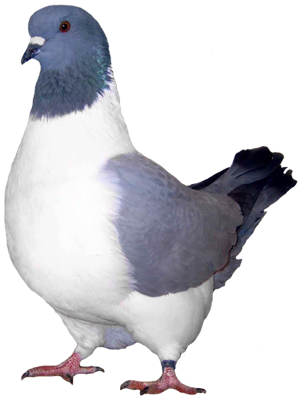
According to Hollander, a homer breeder from Holland by the name of C.J.A.C. Bol reported his breeding tests with colors and patterns of Racing Homers in 1926 (Origins And Excursions In Pigeon Genetics, P.59). Because the barless ash-red phenotype looks very much like an ordinary spread ash-red, this breeder from Holland might have thought that he had barless ash-red. He did not do any actual breeding tests of this and therefore his personal observations have been ignored by the scientific community. Bol also assumed without valid breeding evidence that light grizzles, showing mostly whitened wing shield, were also barless. According to Hollander, both of these assumptions have been found subsequently to be unjustified, but many breeders still are fooled in the same way. In fact, homer breeders regularly refer to spread ash-red as “barless mealy” or “barless silver”. It should be noted that "spread ash-red" and "ash-red barless" are genetically different mutations mimicking each other. Mating such birds to any pattern of the blue series (except spread) would solve the problem. If you get any spread black offspring from this mating, you can stop to experiment and conclude that the original bird was spread ash-red, not barless ash-red.
“Few breeds have the barless pattern in their repertoire. It is fairly common in Swiss breeds – the Eichbuhler, Berne, Zurich, and Lucerne types; and in ‘Germany Toy’ breeds – Archangels (Gimpel), Ice Pigeons, Monks, Priests, and Swallows. It is also common in Coburg Larks and in the Crested Soultz, both of these breeds probably of recent origin from crosses involving Toy breeds. Strassers (picture on the right - provided by Jim Gifford), of course commonly are barless. The only Pouter type which I have heard of being barless pattern is the Bohemian. Barless blue Racing Homers in Wisconsin, according to comments I got at shows, appear to have been developed from Strasser crosses. Whether independent sources of the pattern exist is not certain, but rarely such a bird has appeared in other Racing stocks.
Up to 1940, so far as I know, barless blue was non-existent in all the Tumbler breeds, Fantails, Modenas, Oriental Frills, Runts, Maltese Kings, Mondains, and numerous less ordinary breeds. Barless seems then to be primarily of Central European origin. Probably it was deliberately crossed into the Strasser, Larks, and Shoultz, although their origins are not very clear. My guess then is that the mutation to barless occurred relatively recently – that is, less than a thousand years ago, rather than in extremely ancient times” (Hollander, Origins And Excursions In Pigeon Genetics, P.59-60).
Hollander also shares his personal communication with Dr. Dieter Harmuth of Staufen, East Germany (NPA news October 1960, pages 19-20). Dr. Harmuth crossed a hand-raised female Wood Pigeon X smoky blue bar Denzing Highflier cock and obtained an F1 showing definite wing bars. According to Hollander, this result suggests that the barless wing pattern of the Wood Pigeon is genetically the same as that of barless domestic pigeons. The same argument applies in crosses of ringneck dove (Streptopelia risoria) X barred domestic pigeons as the F1 shows a faint tendency to wing bars. According to Frank Mosca, what this data and the argument that Dr. Hollander and Dr. Harmuth suggests is that there is analogous mutation at the same spot on the chromosome in both Columba livia and Columba palumbus (Wood Pigeon - see picture below). Identical mutation here means that since pigeons are related evolutionarily, we'd expect major parts of their genomes to be identical. The same mutation in one spot in one species, would likely lead to an analogous (identical) mutation in another. We have extreme dilute in the ringneck dove and now we have extreme dilute (lemon) in pigeons and no one believes that extreme dilute was added to pigeons from the doves - rather there was the same mutation at the same spot in two different species (Frank Mosca, private communication).
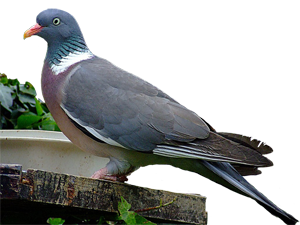 In 1938, W. F. Hollander reported pattern inheritance of Columba
livia as part of his PhD thesis at the University of Wisconsin.
He started his
experiment
with crossing blue barless Strasser and found that bars along with other
patterns
never gave barless in F1. He concluded that barless is a recessive mutation. “Backcrosses
to barless, and F2 progeny showed that barless is alternative (allelic) to checker
X barless was mated back to barless. The backcross produced about equal numbers
of checker and barless squabs – never any barred. From these results, I
concluded that barless was here the effect of a gene which I symbolized c, checker
on the other hand having C” (Hollander, Origins And Excursions In Pigeon
Genetics, P.59).
In 1938, W. F. Hollander reported pattern inheritance of Columba
livia as part of his PhD thesis at the University of Wisconsin.
He started his
experiment
with crossing blue barless Strasser and found that bars along with other
patterns
never gave barless in F1. He concluded that barless is a recessive mutation. “Backcrosses
to barless, and F2 progeny showed that barless is alternative (allelic) to checker
X barless was mated back to barless. The backcross produced about equal numbers
of checker and barless squabs – never any barred. From these results, I
concluded that barless was here the effect of a gene which I symbolized c, checker
on the other hand having C” (Hollander, Origins And Excursions In Pigeon
Genetics, P.59).
However, in his PhD thesis Hollander admits there are some conflicting breeding results. When we look at the breeding results of his study, two matings of barless male with barred female were mated, yielding 16 offspring, all barred, but with a tendency to narrowness of the bars; so, no problems there but when we look at the breeding data he provided, we see that +//c X +//c gave 47 young but only 7 of them were barless with unusual variability, which is pretty far from the expected ideal of 1 in 4 barless ratio. He noted that several of those bar pattern birds had rudimentary or very narrow bars and speculated that some of them may be genetically barless.
According to Hollander’s
study, pigeons have four alleles in the pattern series which are
Barless (c), wild-type (C+),
Checker (C), and T-pattern Checker (CT).
Bar pattern is our wild-type in this multiple allelic series and barlessness
is the only recessive allele to the wild-type. The pattern is located
in different locus, known as the c locus and therefore inherited
independently of feather
color mutations. In the blue series, these distinct phenotypes are
listed in the order of their progressive decreasing amount of black
in relation to blue,
and it is interesting that they appear to be epistatic in their hereditary
manifestation in the same order, i.e., each to the one that follows.
However, epistatic is
a condition where one gene suppresses the effects of non-allelic gene.
The key word here is “non-allelic” and therefore, in
a series of alleles dominant and recessive apply but for non alleles
epistatic applies. These rules
of using the right terminology in biology allow us to understand if
we are talking a series of alleles or interactions between two different
genes automatically
by the word used; the two should not be mixed for this reason. 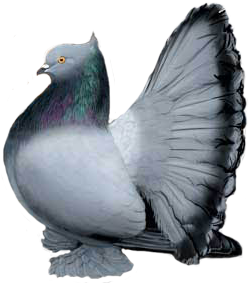
Some people consider the possibility of barless as an autosomal recessive but none-allelic gene to the pattern locus - a linked and epistatic gene to pattern in homozygous state. Let’s consider a minute that barless is not part of the pattern series. If barless was located in a different locus, and conceals (epistatic) the pattern locus alleles in homozygous state, that would mean that any barless bird could carry T-pattern check (CT), check (C), and wild-type (C+) genes at the pattern locus. In this scenario, let’s assume there is a barless bird that is homozygous check (C//C) at the pattern locus but can’t show the check pattern in its phenotype since we are assuming barless is a different gene located at some other locus that is epistatic to pattern in homozygous state. If we mate this bird (c//c at the barless locus and C//C at the pattern locus) to a homozygous wild-type (C+//C+), we would expect to get heterozygous check (C//C+) at the pattern locus and carrying a single copy of the barless gene (c//+) at the so-called barless locus. In other words, we would expect to make a checker from a barless to wild-type (barred) mating. However, our breeding data clearly indicates that in the pattern series lower dominant genes never produce higher dominant genes. Thus, no one ever produced a T-check pattern from barless to check mating, or produced a check from barless to bar mating. When we mate check to check we can get check, bar, or barless, but never a T-pattern check. Therefore, the idea that barless is a recessive not allelic to pattern and epistatic to pattern when homozygous simply does not fit the observed facts.
Barless is an autosomal
recessive trait that is symbolized as (c//c),
which can be the only condition (homozygous state) for pigeons to
show barless pattern in their phenotypes. A pair of barless can produce
nothing but barless offspring. As the name implies, the barless mutation
simply erases the bars from the wing shield of the birds, and that
seems to be the only observable affect this mutation has over the
wild-type phenotype. In barless birds, the so-called blue has entirely
replaced the black wing bars leaving a clear blue wing, except for
the darkened tips of the primaries, secondaries and tertiaries. In
addition, the barless pattern does not occur only on blue series
but also in every other mutant except mutants which are epistatic
to pattern like recessive red, spread, recessive white, white side,
and albino. In addition, heterozygous tiger grizzle, homozygous classic
grizzle, homozygous indigo, and homozygous almond (cock birds only)
also conceals the pattern. We can see the barless in ash-red, brown,
hetero indigo, hetero grizzles,
milky, dilute, pale, reduced, extreme dilute (lemon), frill stencil,
toy stencil, ice, recessive and dominant opal, all heterozygous and
hemizygous almond series, dirty, etc. In addition, when we look at the
pattern, it is to be noted that color appears in the rump and in
the outer vanes of the outer
tail feathers
(albescent strip) are inherited independently of the pattern series.
It should also
be noted
that even though each pattern darkens or lightens the feather colors,
the effect of
pattern series is more distinctive on the wing shields. The patterns
differ from each other only in the amount and position of coarse
spreading. The
barless pattern
lacks it almost entirely; the other patterns show in serial array
increasing invasion in the wings, the crop, and finally nearly
all the body feathers
anterior to the tail.
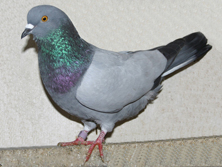 |
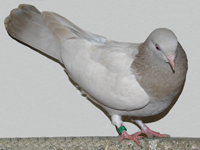 |
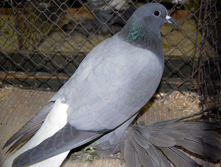 |
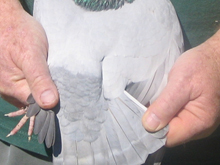 |
Picture
1 – Blue Barless Roller (Breeder: Arif Mumtaz
), Picture 2 – Silver Dun Barless Roller
(Breeder: Arif Mumtaz ),
Picture 3 - Blue Barless White Tail Saxon (Taken
from: http://unitedswallowclub.com Breeder: Hans-Jürgen Schwind), Picture
4 – Recessive Opal Barless
(Breeder: Ronald Huntley).
Click on each picture to enlarge them.
Although for the average fancier barless is a recessive trait, both Graefe and Quinn reported that barless gene does not segregate out like an ordinary recessive gene. It seems we have three curious cases about the barless pattern. First, from the Hollander’s report on pattern, we don’t know why wild-type hetero barless crosses produce less than expected 1 in 4 ratio, but checks that are hetero for barless produce the expected 1 in 4 ratio. Second, in some cases wild-type hetero for barless show narrowness of wing bars but in some cases it doesn’t. Lastly, there seems to be a strange relationship between foggy vision and barless pattern but this curious case only show up in some barless birds. Although, we probably won’t get real good answers to these questions from the breeding results, and will have to wait until the pigeon DNA is sequenced, we can make some reasonable speculations and educated guesses.
First, let’s evaluate why barless allele reacts differently when tested against check and T-pattern check versus wild-type. Many people have made anecdotal reports of hetero bars producing in lower than expected percentages barless, so it is not unique to Hollander's work when he was a graduate student. These results however, no place close to low enough to give any statistically valid reason to reject the idea that barless is not a pattern allele. Hollander speculated that some birds that were genetically barless still showed some bar and even observed birds in this last set of four tests that while they showed bars he called the bars "rudimentary" compared to normal. When we look at the barred birds, we can see that the bar pattern comes in variety of size and darkness. This could very well be explained by the presence or absence of some other mutant genes in the genotype. Or, perhaps whatever causes the third bar or a single bar in a barred bird will produce a rudimentary bar in a barless bird. Another good question to wonder is the possibility of pigeons having more than one type of bar pattern. What if there are alleles of bar pattern which we can’t observe on the phenotype but it is present in the genotype? This is not a very unusual case if you think about it. For instance, from the DNA sequencing we know that there are at least 60 alleles of albino gene found in humans. However, by looking at the phenotypes of these individuals, we cannot tell them apart. This makes me wonder, if there are in fact more than one bar pattern in pigeons. Furthermore, when we look at the pattern series, there seems to be many alleles that differ in the phenotype. If the wild-type gene does not to function the way it supposed to, than we can get recessive, dominant and co-dominant alleles. It is more often we see genes become complete dominant or complete recessive. Therefore, it seems very easy to wreck a gene’s function 100% or close to make that gene a complete recessive. It is however, harder to wreck it by 20%, and 40% and 60% and 80%, yet that is what the pattern phenotypes seem to indicate especially if we add the light checker, dark checker and third bar to this multiple allelic series. Unlike the albino example in humans, in the multiple series of the patterns of pigeons, we can clearly see the difference between each pattern. This leads me to believe that there could be other possibilities with regards to pattern series – more than one type of bar. If this theory is correct, and there are more than one type of bar pattern then this can explain the one behaves normally and other abnormally as in Hollander’s experience when he tested the barless to bar. In addition, in view of the wide range of bar widths that is normal in a variety of breeds, two different alleles for bar is not unreasonable.
According to Dr. Cryberg, for an allelic series like pattern to give us many different phenotypes the way patterns do, and for that mutation to break the pattern gene on a near continuum is nearly impossible. “It is far more likely to be mutations in the switches or promoters that govern gene expression. This sounds much like beak size and shape in Darwin's finches. We know today that those are due entirely to switches and not genes and very likely with a large dose of epigenetics also as there is no way to explain the very rapid changes observed other than epigenetics. In such a case pattern could also very easy involve a bit of epigenetics thrown in on top of DNA stuff. There is simply no practical way to sort out questions like this via breeding tests,” says Dr. Cryberg (private communication).
 |
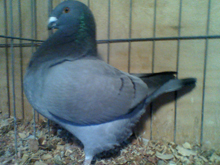 |
When some wild-type birds are heterozygous for barless (+//c) they show significant bar size reduction (narrowness of bar), but some look normal. This phenomenon is so interesting that narrowness of the bar can show in only one of the nest mates. Hollander thought narrowness of wing bars is a common condition in pigeons heterozygous for barless, and therefore the barless gene can be considered as “incompletely recessive gene”. In addition, this phenomenon leads me to believe that, there could also be multiple versions of barless pattern. After all, we have at least three checks and two T-checks according to some people. So, why can't there be two barless? Furthermore, it is important to note that the narrowness of the bars can also caused by presence of other mutants in the genotype which can create variety of bar widths in different breeds.
The Show Homer pictures above are provided by Joe Braun. You can click on each picture to enlarge them. According to Braun, these birds are full siblings bred in individual pens and they are both wild-type heterozygous for barless (+//c). The picture on the right is the hen with the narrow bars, and the cock nest mate on the left seems to have normal bar size. According to Braun, the father of these birds was a blue check out of a blue check cock and a barless hen. This makes the father of these birds check hetero for barless (C//c). This also means that their father could have donated either check or barless to his offspring and from the pattern of these offspring we know their father must have donated barless to both; otherwise they would have shown the dominant check allele in their phenotype. The mother of these birds was an indigo hen homozygous wild-type for pattern (+//+). Since she could have only donated one of the wild-type patterns to her offspring, this explains why these birds (pictured above) are wild-type heterozygous for barless (+//c). Based on this sibling example, it seems there is some evidence that heterozygous barless hens have narrow bars, while the heterozygous cocks do not. We also have some fanciers reporting that they have never seen heterozygous barless birds with narrow bars. One possible explanation to this phenomenon, although it might seem extreme and not justified, is perhaps there are other genes involved that act together with heterozygous barless to either give narrow bars or normal width bars and these other genes are sex mediated. In addition, Braun reports that the paternal grandmother of these birds, which was a homozygous barless hen, did have some kind of vision problems. She acted like she could only see shadows. She was able eat but from her movements it was obvious that she had some vision problems. Her eyes looked normal but they did seem to protrude or bulge more than a normal pigeon.
According to Hollander, a strange relation between barless and defective vision (semi-blind, or “foggy vision”) has been repeatedly observed in some derivatives of crosses. The interesting part is some barless birds never show any vision problems, but there are some that do. Lines of barless homers, for instance, have been successfully raced. In July 1987, Robert J. Mangile reports his experience with foggy vision and barless pattern in American Pigeon Journal. According to Mangile, he received a blue barless cock from Hollander in 1983, several years after Hollander was already working and trying to understand its mode of inheritance. When Mangile started to study this linkage he saw wide range of expressions in the offspring that he produced:
“After about half grown, some can be identified by their peculiar behavior when you approach them closely. They appear to have a frozen owl-like gaze in your direction with their bill slightly elevated. Unlike normal birds which seem comfortable viewing you with one eye, foggy birds tend to look at you over their bill, with both eyes, not unlike a real owl. This aspect may shed light on the malady. Their skull appears wider between the eves, thus producing a flattened ‘knob-like’ head with wide-set eyes (see photos). In a few instances the widened skull was noted in newly hatched squabs.
Foggy vision - blue barless cock, #040-E. Note width of forehead (between eyes) in Figure 1; and the "knob-like" appearance of forehead in Figure 2.
Fledglings appear to be vision-impaired and less mobile than loft mates; and restricted to the floor. With ensuing age mobility seems to increase, suggesting either adaptation to their condition(s) or that their vision has improved; or both? As adults, some tend to fly to upper roosts freely and some limit themselves to the lower two feet of roosting sites. None of my foggy birds nested in upper level boxes,” says R. Mangile (What Is "Foggy" Vision?).
Mangile concludes that foggy vision appears to be hereditary. When foggy is mated with normal birds, all the offspring were normal. Backcrosses and brother X sister matings produced both foggy and normal which indicated that foggy was a recessive trait. However, when Mangile mated foggy with another foggy, instead of getting expected foggy offspring, as the normal simple recessive gene would act, he produced both foggy and a small percentage of normal offspring. From these results, Mangile concludes that the wide variability of this trait is inadequate and/or the mode of inheritance is not simple. According to Dr. Cryberg, this phenomenon of two homozygous recessive individuals producing normal offspring is called expressivity. “Some traits have variable expressivity and can range from normal to quite abnormal. Some of this variation in expression is probably simply genetic noise, some is probably epigenetics and some is probably modulation by other genes. None of these three things is ever held very constant in most breeding and particularly in pigeons. The prime examples where expressivity is all over the map is web footed mutants and polydactyl mutants. In both cases the same apparent genetics often leads to quite a range of expressivity,” says Dr. Cryberg (private communication).
It seems the vision problems caused by barless pattern are related, but not 100% proven, and this situation leaves us with additional curious situations about barless. Some breeders report that they have eliminated the vision defect without a major problem from the gene pool of their barless strains which leads me to believe that barless and vision defect might be caused by two tightly linked genes. However, no one has ever reported this linkage showing up on non-barless birds after a crossover. If barless and vision defect genes were linked, all that had to happen was at some point one crossover happened to give a barless not linked to a vision defect gene and they were able to make normal vision barless. This scenario would also suggest that originally, a lot of those barless would have been heterozygous for the vision defect gene but with time and selection for normal vision they slowly beat the % of vision defect mutants down to the point that they no longer show up. It is also possible that occasional crossovers also diluted out the vision defect problem. On the other hand, if in fact there was a so-called vision defect gene that was tightly linked to the pattern locus, why then non-barless with eye problems never been produced or reported after a crossover? A better question is: why is this vision problem gene affecting only the barless pattern, but not the other alleles of the pattern series? Therefore, instead of the “vision problems linked to barless” idea, I think barless being semi-lethal in a homozygous state seems to be a more reasonable argument and/or explanation to me.
It is pretty clear that something is wrong with the idea that barless is a simple recessive to wild-type. On the other hand, barless does seem to be a simple recessive to higher patterns. It is also clear that barless is incompletely recessive since in some heterozygous birds we can observe narrow and rudimentary bars. Foggy vision is another phenomenon that comes with the barless pattern, but no one seems to know the exact reasons. There seems to be more work to be done in the pattern series, where certain things don’t make a whole lot of sense. It seems more than seventy years have passed after Hollander’s report and we still do not know much about the pattern series.
References:
1. Braun, J. Private communication.
2. Cryberg, R. PhD.
Private communication.
3. Hollander, W. F.
(1938). Inheretance of Certain "Blue-Black" Patterns
and "Bleached" Colorations
in the Domestic Pigeon. Genetics: 23 12-23
4. Hollander, W. F. (1983). Origins And Excursions In Pigeon
Genetics: A Compilation. Burrton, Kan.: The Ink Spot.
5.
Jones, S. v. H. (1921). Studies on Inheretance in Pigeons IV. Checks
and Bars
and Other
Modifications of Black. Genetics 7: 466-507
6. Quinn, Joe W. (1971). The Pigeon Breder’s Notebook. QB&Q
Publishing.
7. Mangile,
R. J. (1987). What Is "Foggy" Vision?
American Pigeon Journal
July 1987, pages 27 & 28. Retrieved April
05, 2012, from http://mail.sumnercomm.net/~rmangile/Pigeons/FoggyVis.html
8. Mosca, F. Private communication.
Copyright April, 2012 by Arif Mümtaz